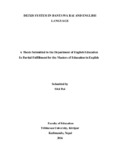Please use this identifier to cite or link to this item:
https://elibrary.tucl.edu.np/handle/123456789/1952| Title: | Deixis System in Bantawa Rai and English Language |
| Authors: | Rai, Sital |
| Keywords: | English language;Linguistic |
| Issue Date: | 2016 |
| Publisher: | Faculty of Education, Tribhuvan University Kirtipur |
| Abstract: | The present study entitled "Deixis System in Bantawa Rai and English Language" was a modest attempt made to find out,compare and contrast the person, place and time deixis in Bantawa and English languages. This study is designed on the survey research and sample population consisted of 30 Bantawa Rai speakers of Homtang VDC of Bhojpur who were selected through nonrandom judgmental sampling procedure. A set of structured question was the tool used to collect data. The data were analyzed, interpreted and presented descriptively and statically by using tables. From the data analysis, it is found that Bantawa Rai has three persons, namely first, second and third, subjective, objective and genitive cases and singular, dual and plural in numbers. In first person deictic expression, there are exclusive and inclusive and in second and third person deictic expressions have honorific and non honorific. Bantawa Rai time deictic expressions have tense system (Present, Past and Future), proximal and distal distinction, point of time and period of time, pure and impure distinction. It was also found that pure English time deictic expressions are changed into pure and impure, proximal, distal and neutral classes and gestural and non-gestural deictic expressions in Bantawa. This research study consists of five chapters. The first chapter focused with an introduction followed by background of the study, statement of the problem, objectives of the study, research questions, significance of the study, delimitation of the study and operational definition of the keys terms. In the second chapter, the researcher has mentioned review of theoretical literature, review of the empirical literature, implications of the review for the study and conceptual framework. The third chapter deals with methods and procedures of the study. Similarly, the fourth chapter involves the analysis and interpretation of results where the both statistical and descriptive approaches are used.Finally, thefifth chapter involves conclusions and recommendations of the study. The reference and appendices forms are the concluding part of this thesis |
| URI: | http://elibrary.tucl.edu.np/handle/123456789/1952 |
| Appears in Collections: | English Language Education |
Items in DSpace are protected by copyright, with all rights reserved, unless otherwise indicated.

